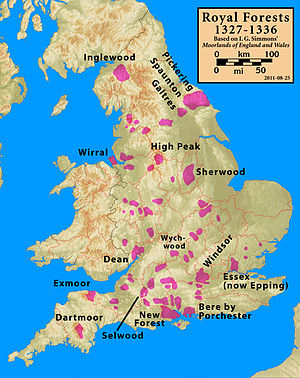Inglewood Forest

Inglewood Forest is a large tract of mainly arable and dairy farm land with a few small woodland areas between
Etymology
Inglewood is first attested in the forms Englewod’ (c. 1150), Engelwode (c. 1158) and Englewud (1227).
History
Soon after the
The forest boundaries changed many times and included at one time most of the Cumberland
The forest ultimately belonged to the
The borough and city of Carlisle (the area within the city walls) was outside the forest though Penrith was within it and was the main administrative centre and market town for the southern part of the region.
| Grid reference | Name | Location | NHLE | Sources for "peel"/"pele" |
|---|---|---|---|---|
| NY505458 | Armathwaite Castle | Armathwaite | 1145496 | Pevsner;[5] Ordnance Survey[6] |
| NY476384 | Brackenburgh Tower | Calthwaite | 1145499 | Pevsner; see Perriam and Robinson[7] |
| NY478320 | Catterlen Hall | Catterlen | 1012829 | Pevsner |
| NY475524 | Cote House | Wetheral | 1111822 | Perriam and Robinson,[8] and also Pevsner, say Bastle house; Ordnance Survey[6] |
| NY376515 | Dalston Hall | Dalston | 1087441 | Ordnance Survey[6] |
| NY551367 | St Cuthbert's Church | Great Salkeld | 1100260 | RIBA[9] |
| NY403433 | High Head Castle | Ivegill | Perriam and Robinson | |
| NY518302 | Hutton Hall | Penrith | 1326922 | NHLE;[10] see Perriam and Robinson[7] |
| NY460357 | Hutton in the Forest | near Skelton | 1210817 | Pevsner |
| NY433509 | Newbiggin Hall | St Cuthbert Without | 1087720 | Pevsner |
| NY396436 | Thistlewood | Ivegill | 1326687 | Pevsner; see Perriam and Robinson[7] |
| NY433499 | Woodside | St Cuthbert Without | see Perriam and Robinson[7] |
Literature
The Forest is the setting of many of the adventures in the late medieval
- Lytil Jhon and Robyne Hude
- Wayth-men ware commendyd gude
- In Yngil-wode and Barnysdale
- Thai oysyd all this tyme thare trawale.
According to legend, Inglewood Forest is also home to the outlaws
Honour of Penrith
This section needs additional citations for verification. (September 2020) |
The
William III gave the lands belonging to the manor to his friend William Bentinck, 1st Earl of Portland whose descendants later sold them to their relatives the Cavendish family.
See also
References
- ^ "Close Rolls, March 1244". British History Online. Retrieved 20 September 2020. (reference for the Englewud spelling) Mandatum est Roberto de Ros, justiciario foreste, quod in foresta de Englewud' faciat habere vicecomiti Cumberl' x. quercus ad reparandam et lambruscandam capellam in castro regis Karleoli. Teste ut supra.
- ISBN 9789004349490.
- ^ Higham, N. J. (1986), "The Origins of Inglewood Forest" (PDF), TCWAAS, 86: 85–100
- ^ a b Bain, Joseph, ed. (1884). Calendar of documents relating to Scotland, volume 2, 1272-1307. H.M. General Register House, Edinburgh.
- ^ Pevsner, Nikolaus (1967). Cumberland and Westmorland. Yale University Press.
- ^ a b c Labelled as a Peel on 1:25000 Ordnance Survey maps
- ^ a b c d For these entries, Perriam and Robinson list sources for "Peel" without comment
- ^ Perriam, Denis; Robinson, John (1998). The Medieval Fortified Buildings of Cumbria. CWAAS.
- ^ Royal Institute of British Architects. "St Cuthbert, Great Salkeld, Cumbria: the pele tower". Retrieved 20 September 2020.
- ^ Historic England. "Details from listed building database (1326922)". National Heritage List for England.
- ^ Sean Pollack, 'Border States: Parody, Sovereignty, and Hybrid Identity in "The Carl of Carlisle"', Arthuriana, 19.2 (summer 2009), 10-26 (p. 10).
- ^ Winchester, Angus; Straughton, Eleanor. "Cumbrian Manorial Records". Lancaster University. Retrieved 12 March 2022.
Sources
- Parker, F.H.M. (1905). "Inglewood Forest : part 1". Transactions of the Cumberland and Westmorland Antiquarian and Archaeological Society. 2nd series. 5. Carlisle: The Society: 35–61.
- Parker, F.H.M. (1906). "Inglewood Forest : part 2". Transactions of the Cumberland and Westmorland Antiquarian and Archaeological Society. 2nd series. 6. Carlisle: The Society: 159–170.
- Parker, F.H.M. (1907). "Inglewood Forest : part 3". Transactions of the Cumberland and Westmorland Antiquarian and Archaeological Society. 2nd series. 7. Carlisle: The Society: 1–30.
- Parker, F.H.M. (1909). "Inglewood Forest : part 4". Transactions of the Cumberland and Westmorland Antiquarian and Archaeological Society. 2nd series. 9. Carlisle: The Society: 24–37.
- Parker, F.H.M. (1910). "Inglewood Forest : part 5-6". Transactions of the Cumberland and Westmorland Antiquarian and Archaeological Society. 2nd series. 10. Carlisle: The Society: 1–28.
- Parker, F.H.M. (1911). "Inglewood Forest : part 7". Transactions of the Cumberland and Westmorland Antiquarian and Archaeological Society. 2nd series. 11. Carlisle: The Society: 1–37.
External links
- Cumbria County History Trust: Hesket in the Forest (nb: provisional research only – see Talk page)
